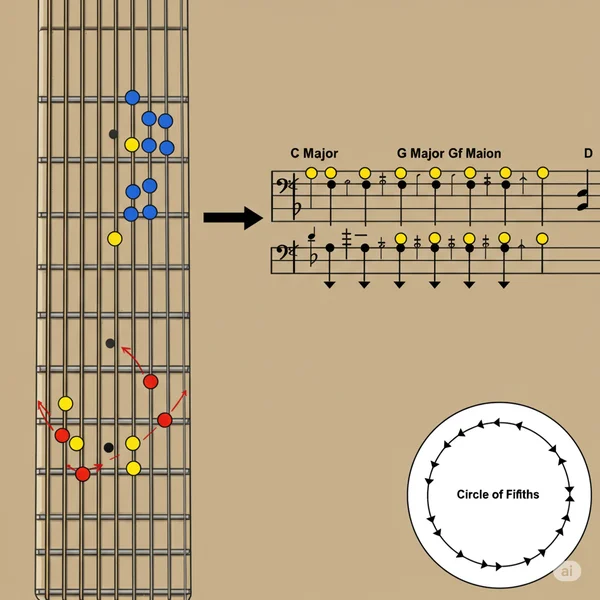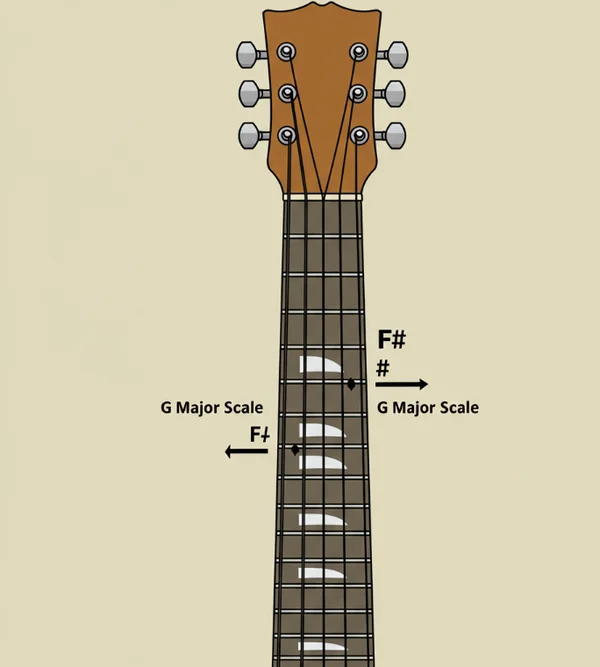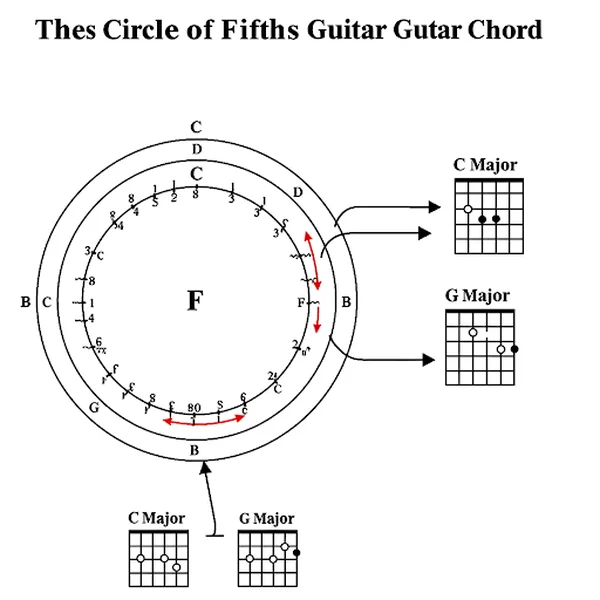Guitar & Circle of Fifths: Master Your Fretboard
Unlock Your Guitar Potential: Applying the Circle of Fifths to Scales, Chords, and Improvisation on the Fretboard
Many guitarists find music theory a hurdle, especially linking concepts to the fretboard. How can the Circle of Fifths help my guitar playing? This powerful tool, often seen as just a diagram, is actually a roadmap to understanding key relationships, building chords, navigating scales, and unlocking your improvisational creativity directly on your guitar. This guide will show you exactly how to use the circle of fifths guitar to transform your understanding and playing. Ready to see how it all connects? Explore our interactive tool and follow along!
Quick Recap: What is the Circle of Fifths for Guitar Players?
Why is the Circle of Fifths vital for guitar players? Is the Circle of Fifths important for guitarists? Yes.
Core Concepts for Fretboard Application
At its heart, the Circle of Fifths visually organizes all twelve musical keys. Clockwise, keys are a perfect fifth higher; counter-clockwise, a perfect fourth higher. For guitarists, this means understanding key relations, sharps/flats, and how chords connect – foundational for fretboard navigation.
Navigating Keys: Fifths, Fourths, and Your Guitar
Understanding this movement is key. For example, knowing G is a fifth above C helps you quickly find dominant chords (the V chord) or related keys. This directly translates to how you find shapes and patterns across the guitar theory fretboard. Many common guitar licks use these movements.
Visualizing the Circle of Fifths on Your Guitar Fretboard
Seeing theory on the guitar neck can be tough. How do I visualize the Circle of Fifths on a guitar? It's about connecting the diagram to physical shapes and locations.

Mapping Key Signatures Across the Strings
Each step around the Circle of Fifths adds/subtracts a sharp or flat. For guitarists, certain frets become your "home" for notes in a given key. Recognizing these key signatures guitar patterns helps you stay in key effortlessly.
Finding "Home Base" for Each Key on the Neck
Think of root notes on the E and A strings. If C is your start, G is easily found. As you move around the Circle, trace these root notes. This is a practical way of visualizing circle of fifths guitar patterns.
Connecting Open String Shapes to Movable Patterns
Many open chords (C, G, D, A, E) relate through the Circle of Fifths. Understanding these and transforming them into movable shapes allows playing in any key, key for applying music theory guitar. You can explore these with an interactive visualization here.
Finding and Understanding Guitar Scales with the Circle of Fifths
The Circle is great for scales too. What guitar scales can I find with the circle of fifths?
Locating Major Scale Patterns
The Circle directly shows major key progression. For each, apply major scale patterns. For G major (one sharp, F#), play G major patterns, sharping F. This is fundamental for music scales guitar.

Identifying Relative Minor Scale Shapes for Guitar
Every major key has a relative minor (three steps counter-clockwise). C major's is A minor; they share key signatures. The same C major scale patterns work for A minor, starting on A. This simplifies learning minor guitar scales chords.
A Guitarist's Introduction to Modes via the Circle
The Circle can be a gateway to modes. Knowing your key via the Circle helps identify the parent major scale for modal sounds, adding color to guitar improvisation.
Mapping Guitar Chords and Progressions Using the Circle of Fifths
Here the Circle shines for songwriters. What's the best way to use the Circle of Fifths for guitar chords?
Building Diatonic Chords for Any Key on Guitar
For any key, adjacent keys on the Circle are its dominant (V) and subdominant (IV). With the tonic (I), they form countless song backbones. Our online chord creator shows these relationships.

Common Guitar Chord Voicings and the Circle
The Circle simplifies knowing which chords are major, minor, or dominant seventh. Tonic, subdominant, dominant are usually major. Supertonic, mediant, submediant are minor. This guides guitar chord progressions and songwriting guitar.
The ii-V-I Progression: Your Go-To for Guitar Songwriting
The ii-V-I is common. The Circle easily finds these. Pick a tonic (I), find its dominant (V) clockwise, then its V's relative minor (ii). This is vital for learn guitar theory.
Level Up Your Solos: Circle of Fifths for Guitar Improvisation
For lead guitarists, the Circle frames solos. Can the Circle of Fifths improve my guitar solos? Yes.
Soloing Strategies Over Common Chord Changes
When chords change, your solo should reflect it. The Circle helps anticipate changes and choose scales. If C moves to G, your note choices can reflect that V-I strength. Essential for guitar licks.
Using the Circle to Find Target Notes and Melodic Lines
The Circle helps identify strong "target notes" (like a chord's 3rd or 7th) for purposeful solos and creating smooth melodic lines between keys.
Smooth Key Changes in Your Guitar Solos
To modulate, the Circle shows smooth paths. Moving to an adjacent key often sounds most natural. This is advanced for guitar modes.
Practical Exercises: Applying Circle of Fifths Concepts on Guitar
Practice is key. How to learn guitar circle of fifths involves hands-on work.
Fretboard Drills: Playing Through Key Signatures
Start in C major, play its scale. Move to G major, play its scale (noting F#). Continue around the Circle. This builds fretboard navigation.

Chord Progression Practice Circling Through Keys
Play I-IV-V in C (C-F-G). Transpose to G (G-C-D), then D, and so on. This solidifies guitar chord progressions.
Improvisation Challenges Using the Circle of Fifths
Use a backing track moving through Circle-based keys. Improvise smoothly, using the Circle for scale choices. Excellent guitar practice.
Pro Tips for Integrating the Circle of Fifths into Your Daily Guitar Practice
Make the Circle a natural part of playing.
Warm-ups Focused on Circle of Fifths Patterns
Start practice playing scales/arpeggios around the Circle. Warms fingers and theory brain.
Analyzing Your Favorite Songs with the Circle
Analyze songs' chord progressions with the Circle. You'll see its logic often. Great for applying music theory guitar. For a visual aid, map them on our tool.
Your Fretboard Journey with the Circle of Fifths Starts Now
The Circle of Fifths is a practical tool to revolutionize your guitar approach. From visualizing circle of fifths guitar patterns to understanding guitar scales chords and crafting guitar chord progressions, its uses are vast.
Integrate these into your guitar practice for deeper music understanding.
Ready to see these relationships? Visit our interactive tool now and explore music theory effortlessly.
Circle of Fifths for Guitarists - Common Questions
-
How can the Circle of Fifths help me learn guitar faster?
It provides a logical framework for key relationships, chord construction, and scale patterns, speeding up comprehension on the guitar theory fretboard. It helps you see the bigger picture of music theory for guitar.
-
Is the Circle of Fifths useful for all guitar styles?
Yes! Its principles are universal. From rock to jazz, circle of fifths guitar knowledge is invaluable. Blues often uses I-IV-V relationships shown on the circle.
-
What's the easiest way to start applying the Circle of Fifths on guitar?
Focus on C major. Identify I, IV, V (C, F, G). Find them on guitar. Move to G major and repeat. Our online exploration tool can help.
-
Can the Circle of Fifths help with ear training for guitarists?
Yes. Familiarity with interval sounds (fifths, fourths) and key characteristics trains your ear to recognize these patterns in music.